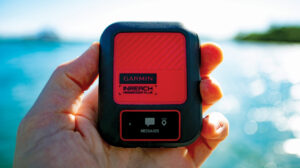Rejuvenation Sensation
Does Pulse Tech’s desulfator work?
We test it on an aging battery to find out.

These close-ups of lead-acid battery plates were supplied by Pulse Tech. In image A sulfation buildup appears as yellowish dots. Image B shows a cleaner battery plate after Pulse Tech treatment.
Last summer, my UPS guy delivered three boxes from Texas-based Pulse Tech Products Corporation. Inside each was the same simple assortment of components, all connected via a long (approximately 14 foot) electrical cord. At one end of the cord was a small (16″ x 5″) solar panel, and on the other end, a set of ring terminals sized to accommodate the lugs of a marine battery. In between was a boxy plastic device not much larger than a cell phone charger and prominently labeled “SolarPulse Industrial Solar Charging System.”
An exciting deal, that delivery. After all, I’m a guy, who despite the passage of the years still retains the enthusiasm he used to have for high school science experiments. I was looking forward to giving Pulse Tech’s solar-powered desulfation technology a try, particularly in light of the research I’d done concerning its development and efficacy.

The ERV model that we tested has a larger collector than the SP5 model and retails for $199.95. The SP2 with the smallest collector carries a list price of $99.95.
The concept of desulfation is a little mysterious. According to Pulse Tech, the idea was initially stumbled upon by accident when inventor Wilford Burkett found that for some reason charging a battery with fast rise-time pulses at carefully controlled frequencies and rates could cause a resonance within the battery, rather like ringing a bell. This ringing, Burkett further discovered, could cause sulfation crystals—the little devils that accumulate on the lead plates of older and/or unused lead-acid batteries and reduce both capacity and cranking power—to shatter like wine glasses and return to the battery’s acid as active electrolyte. Such conditioning, Burkett concluded, could keep sulfates from building up in new batteries and rejuvenate older batteries by reducing established sulfate accumulations, and even bring some dead batteries back to life.
My test platform was my own boat, Betty Jane. I had three Deka Dominator 4D gellcell batteries onboard, all approximately five years old—prime candidates for some life-extending rejuvenation—and parallel-wired into a single battery bank maintained by a shore power-energized Freedom 2000 inverter/charger. Certainly I had a scientific axe to grind by adding Pulse Tech technology to Betty’s electrics: I wanted to know whether it actually works in the real world. But I had a financial axe to grind as well. Given the $600 cost of one new Deka 4D gellcell, I theorized that being able to extend the life of all three would save me hundreds of dollars in the long term.
The plan was simple. I’d start by attaching the ring terminals of one Pulse Tech SolarPulse unit to one of my Dekas. Given the dollars involved, I was hesitant to directly commit all three to the experiment, at least for starters. (I was also reasonably sure the resistance inherent in the whole bank’s beefy cables and connectors would prevent the SolarPulse’s 350-milliamp shots from affecting the other two batteries.) Then I’d temporarily position the solar panel in a sunny location, like the roof of Betty’s forward cabin. The length of that 14-foot interconnecting cord and my hinged central windshield panel that can be raised slightly and locked in place would facilitate a workable temporary arrangement, as would an engine-room shelf that could support the little plastic SolarPulse charging unit.

This SolarPulse SP5 model is similar to the unit we tested but with a smaller solar collector. It’s priced at $179.
One preliminary step was necessary before I could begin though: I had to measure the baseline strength of the test battery prior to the SolarPulse hookup. To do this, I used a Lester Electrics Battery Discharge Unit (BDU), which in a very controlled way discharges a battery at a rate of 75 amps from full charge down to approximately 10.5 volts while recording the minutes and seconds the discharge takes. This last bit of data is critical—the longer the time, the healthier and stronger the battery.
I hauled the BDU into Betty’s engine room, and after disconnecting the test Deka from the rest of the battery bank and attaching the BDU’s positive and negative clips to its lugs, I initiated the discharge program and at length came up with some numbers that seemed plausible in light of the Deka’s age. Time to discharge was 55 minutes and 40 seconds, a finding that meant the battery had slightly more than half its original strength, at least compared to the 105-minute time to discharge a brand new 4D gellcell according to East Penn, the manufacturer of Deka batteries.
Then I reconnected the test battery to Betty’s system and attached the SolarPulse’s ring terminals. I mounted the solar panel in the aforementioned rooftop spot and began the experiment in earnest, letting things percolate along until early February of this year, a period of about six months. During this time, by the way, the panel was exposed to a bit less sun than normal since our most recent winter in North Florida was comparatively rainy, overcast, and cold.
Test results were fairly positive, nevertheless. After using the same Lester BDU as before to make the February measurement, I discovered that the test battery’s time to discharge was 46 minutes and 42 seconds—about 11 minutes less than it had been six months before. This finding was just a tad deceptive, though—in fact it constituted a slight endorsement of Pulse Tech’s technology, once an additional, heretofore unmentioned, detail was factored in.
When I’d measured time to discharge at the beginning of the experiment the temperature in Betty’s engine room had been 80F. In February, when I made the measurement again, the temperature had slumped to 50F. After carefully examining a graph in the authoritative Curtis Battery Book that shows precise numerical values for the indirect relationship between relative battery capacity and temperature, I discovered that my experiment’s 30F differential was dragging the February measurement down by exactly 20 percent. Boosting the reading upwards by that amount produced some new numbers: 58 minutes and 24 seconds. The test battery’s time to discharge had been increased by 2 minutes and 40 seconds.

One of the recording sessions
Pulse Tech’s sales and marketing head Robert White offered a straightforward interpretation of this little development. “The extra discharge time you’re getting most from your test battery likely shows some rejuvenation of your battery,” he said. “And that means you may have extended its life slightly.”
My interpretation’s somewhat more reserved. One thing I’ve learned from this experiment is that battery testing in the real world is subject to a variety of issues and complexities. One test battery, for example, may perform differently from another and produce different test results, despite identical specifications. And adding an extra charger—even a small one—to an existing system may produce effects that defy explanation. In any case, a statistical approach to several batteries over a period of several years, it seems to me, is the only way to draw accurate, definitive battery-test conclusions.
But on the other hand, the SolarPulse seems to perform. So, based on my test results, I’ve decided to hook up all three of the SolarPulse units to Betty’s battery bank in the near future and check the dnouement some time later this year. Stay tuned.
Pulse Tech
(800) 580-7554
Deka batteries
(610) 682-6361
This article originally appeared in the April 2011 issue of Power & Motoryacht magazine.










